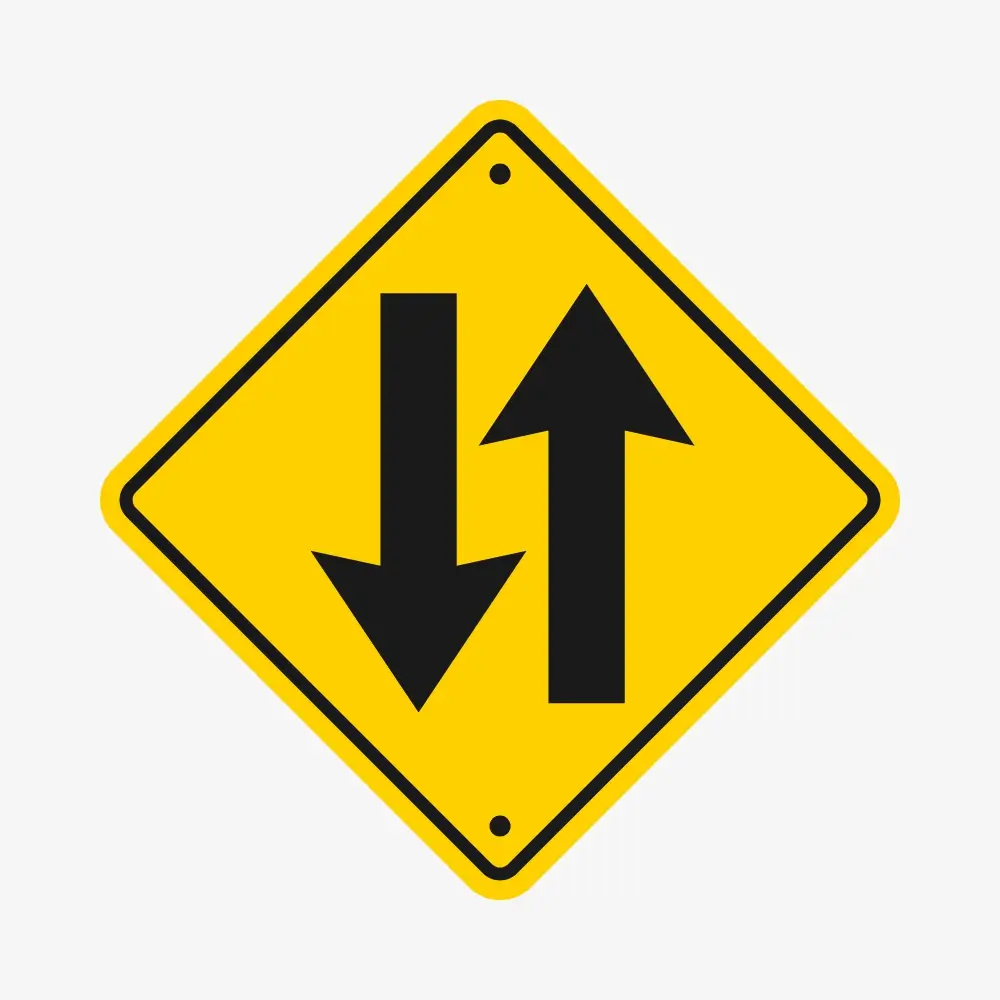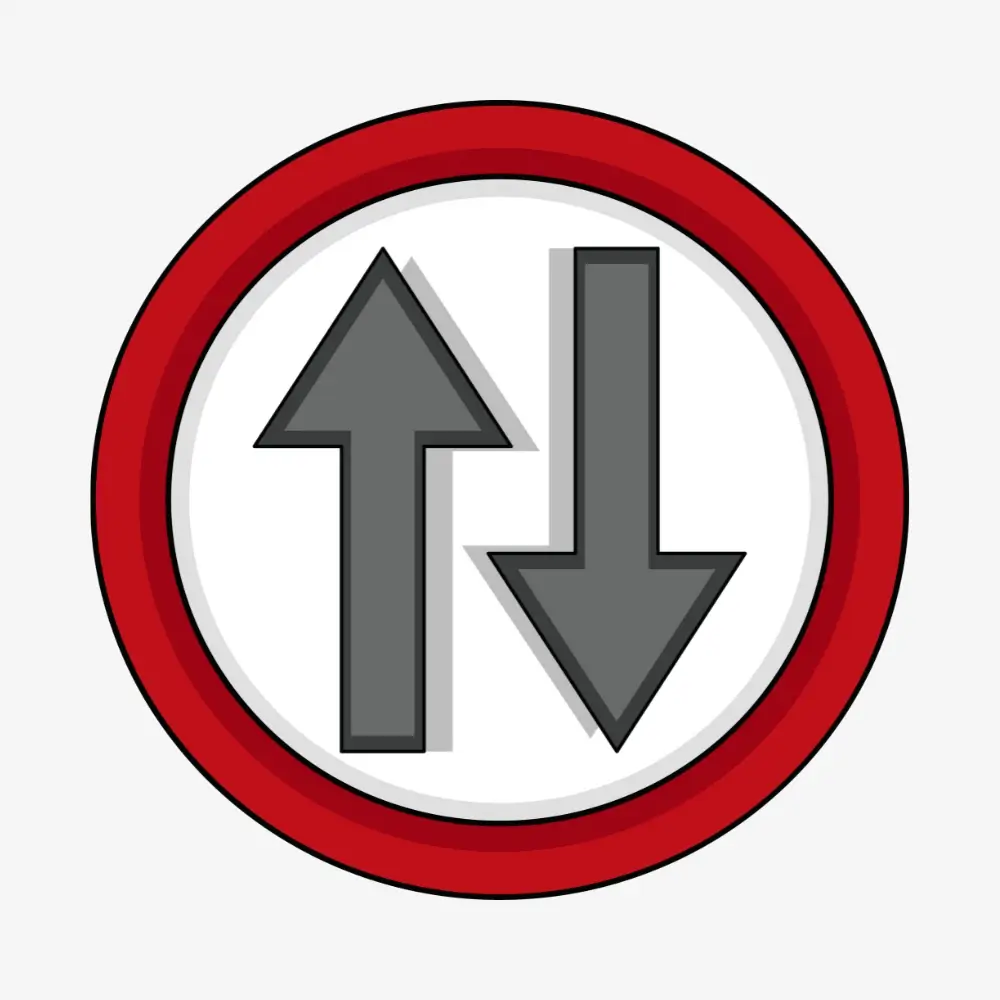Navigating roads safely requires understanding various traffic signs that regulate, guide, and warn drivers. One of the most essential warning signs is the Two-Way Traffic Sign, which alerts drivers that they are leaving a one-way roadway and entering a section of road where traffic flows in both directions.
This article explores everything you need to know about the Two-Way Traffic Sign, including its meaning, purpose, and best practices for road safety.
What Is a Two-Way Traffic Sign?
A Two-Way Traffic Sign is a warning sign designed to inform drivers that they are about to enter a roadway where vehicles travel in both directions. This sign is crucial for road safety, especially in areas where a driver may have previously been on a one-way road and is now transitioning to a two-way road.
Key Features of a Two-Way Traffic Sign:
- Type: Warning sign
- Color: Yellow background with black arrows
- Shape: Diamond-shaped
- Symbol: Two black arrows pointing in opposite directions
- Location: Placed before or on a two-way roadway, typically at transitions from one-way streets
This sign serves as an early warning system, helping drivers adjust their driving behavior by preparing for oncoming traffic.

What Does the Two-Way Traffic Sign Mean?
The Two-Way Traffic Sign means that traffic moves in opposite directions on the road ahead. When drivers see this sign, they should adjust their speed, stay in their lane, and be alert for approaching vehicles.
This sign is especially useful:
- When a divided highway ends, merging into a standard two-way road.
- In construction zones where one-way traffic may have been temporarily converted into two-way traffic.
- When a road layout has changed due to special events, detours, or rerouting.
How Does This Sign Help Drivers?
- Alerts drivers to be cautious and aware of oncoming traffic.
- Prevents head-on collisions by reminding motorists to stay in the correct lane.
- Improves traffic flow by reducing confusion, especially for drivers unfamiliar with the area.

The Purpose of a Two-Way Traffic Sign
The primary purpose of a Two-Way Traffic Sign is to ensure safety by alerting drivers to the presence of oncoming vehicles.
Why Is It Important?
- Prevents Wrong-Way Driving: Without this sign, a driver might mistakenly assume they are still on a one-way road and drive on the wrong side, leading to potential accidents.
- Enhances Road Awareness: It helps motorists stay alert, anticipate the presence of other vehicles, and avoid making dangerous maneuvers.
- Facilitates Smooth Lane Discipline: The sign reminds drivers to stay in their designated lane and avoid reckless overtaking.
- Reduces Traffic Accidents: Head-on collisions are among the most dangerous types of accidents. The Two-Way Traffic Sign minimizes this risk by providing clear instructions.

Where Are Two-Way Traffic Signs Installed?
Two-Way Traffic Signs are strategically placed in locations where drivers need early warning about opposing traffic flow. These signs help prevent accidents, improve traffic awareness, and guide motorists safely through road transitions.
Common Locations for Two-Way Traffic Signs
1. At the End of a Divided Highway
- Installed where a divided highway (with separate lanes for each direction) ends, transitioning into a standard two-way road.
- Alerts drivers that oncoming traffic is now present, reducing the risk of head-on collisions.
2. Near One-Way Street Exits
- Placed where a one-way street merges into a two-way roadway.
- Helps drivers adjust their speed and lane position to accommodate oncoming vehicles.
3. Before Road Transitions and Intersections
- Found at intersections where traffic direction changes, ensuring that motorists do not assume a continuous one-way flow.
- Common in areas where new road patterns exist, such as in newly developed urban areas.
4. In Construction Zones
- Used to warn drivers of temporary two-way traffic changes due to roadwork, detours, or closures.
- Essential for minimizing confusion and ensuring safe navigation in work zones.
5. On Rural and Suburban Roads
- Frequently placed on rural roads that may switch from one-way to two-way due to lack of median dividers.
- Provides crucial warnings in areas where road markings may be less visible or where speed limits are higher.
6. In Areas With Special Traffic Rules
- Some streets operate as one-way during certain times but convert to two-way at specific hours (e.g., near schools or business districts).
- Two-Way Traffic Signs help inform drivers of these changes to prevent confusion.
Why Proper Placement Matters
- Ensures drivers receive early warnings about traffic direction changes.
- Prevents dangerous wrong-way driving incidents.
- Helps maintain smooth traffic flow and lane discipline.
- Enhances safety, especially in areas with high-speed or heavy traffic.
Proper installation of Two-Way Traffic Signs is critical to road safety. By alerting motorists to oncoming traffic conditions, these signs help prevent accidents and ensure a seamless driving experience.

What Should Drivers Do When They See a Two-Way Traffic Sign?
When drivers encounter a Two-Way Traffic Sign, they enter a roadway where vehicles travel in both directions. To ensure safe and responsible driving, they should take specific precautions to avoid accidents and navigate the road smoothly. Essential Actions for Drivers:
1. Stay in the Correct Lane
- Drive on the right side of the road (in countries with right-hand traffic) and the left side (in left-hand traffic countries).
- Avoid drifting into oncoming lanes, which can lead to head-on collisions.
2. Be Cautious of Oncoming Traffic
- Expect vehicles approaching from the opposite direction.
- Adjust speed and lane position to maintain a safe distance from oncoming cars.
3. Avoid Overtaking Unless Safe
- Do not pass other vehicles unless it is explicitly allowed and there is clear visibility of oncoming traffic.
- Check for road markings—a solid yellow or white line means no overtaking.
4. Reduce Speed if Necessary
- Adjust your speed to match road conditions and visibility.
- Be especially cautious in curves, hills, and low-visibility areas, where oncoming traffic may appear suddenly.
5. Pay Attention to Additional Signs
- Look for speed limits, warning signs, or road markings that provide more guidance on two-way traffic areas.
- In construction zones, follow detour signs and be aware of temporary lane changes.
6. Be Extra Cautious at Intersections
- When approaching an intersection, watch for vehicles turning across lanes.
- Anticipate cars making left turns, and always yield the right of way when required.
7. Watch for Pedestrians and Cyclists
- Two-way roads often accommodate pedestrians, cyclists, and motorcycles, so stay alert.
- If there is no designated pedestrian crossing, be prepared for people crossing unexpectedly.
Key Takeaways
- Stay in your lane and watch for oncoming traffic.
- Do not overtake unless it is safe and permitted.
- Adjust speed according to road conditions and visibility.
- Look for additional road signs and obey traffic rules.
- Stay aware of intersections, pedestrians, and cyclists.

Common Mistakes Drivers Make When Seeing This Sign
The Two-Way Traffic Sign is designed to warn drivers that they are entering a roadway where vehicles travel in both directions. However, some drivers misinterpret or ignore the sign, leading to dangerous mistakes that can result in accidents.
Here are some of the most common mistakes drivers make when encountering a Two-Way Traffic Sign and how to avoid them:
1. Ignoring the Sign and Assuming It’s Still a One-Way Road
- Mistake: Some drivers, especially those familiar with a previously one-way road, fail to notice the sign and continue driving as if it’s a one-way street.
- Solution: Always pay attention to road signs, especially when transitioning between different road types.
2. Driving in the Middle of the Road
- Mistake: Drivers sometimes stray into the center of the road, assuming there is no opposing traffic. This is dangerous, especially on narrow roads.
- Solution: Stay in your designated lane and anticipate oncoming vehicles at all times.
3. Overtaking Without Checking for Oncoming Traffic
- Mistake: Attempting to pass another vehicle without ensuring there’s enough space and no oncoming cars.
- Solution: Always check for road markings—a solid yellow or white line means no passing. Only overtake when clear visibility and passing lanes are available.
4. Failing to Reduce Speed When Necessary
- Mistake: Some drivers continue at high speeds without considering the risks of oncoming traffic.
- Solution: Adjust speed according to road conditions, curves, and visibility. Reduce speed when approaching intersections or blind turns.
5. Misjudging Turns at Intersections
- Mistake: Making a left turn without yielding to oncoming traffic or assuming oncoming vehicles will stop.
- Solution: Follow right-of-way rules at intersections and ensure a safe gap before making turns.
6. Ignoring Additional Warning Signs or Road Markings
- Mistake: Not paying attention to speed limits, stop signs, or yield signs that may accompany the Two-Way Traffic Sign.
- Solution: Be aware of other traffic signs that provide more guidance about road conditions and driving regulations.
7. Not Staying Alert in Construction Zones
- Mistake: Overlooking the temporary two-way traffic setup in construction zones and continuing to drive as usual.
- Solution: Always watch for detour signs, flaggers, and lane changes in construction areas.
8. Not Accounting for Pedestrians and Cyclists
- Mistake: Forgetting that two-way roads may have pedestrians and cyclists crossing or riding along the side.
- Solution: Slow down in residential areas and near crosswalks, and always check blind spots for cyclists.
How to Avoid These Mistakes?
- Pay attention to road signs—never assume traffic flow remains the same.
- Stay in your lane—don’t drive in the middle of the road.
- Avoid overtaking unless it’s absolutely safe and permitted.
- Reduce speed when necessary, especially on curves and near intersections.
- Yield properly at intersections—don’t assume right of way.
- Follow additional road markings and traffic control signs.
- Be extra cautious in construction zones.
- Watch for pedestrians and cyclists sharing the road.
By staying alert and following these safe driving practices, drivers can navigate two-way roads safely and avoid dangerous mistakes when encountering a Two-Way Traffic Sign.
Conclusion: Why the Two-Way Traffic Sign Matters
The Two-Way Traffic Sign plays a vital role in road safety, warning drivers that they are entering a section of roadway with opposing traffic. It helps prevent wrong-way driving, head-on collisions, and dangerous overtaking maneuvers.
Key Takeaways:
✔ Alerts drivers about opposing traffic flow.
✔ Reduces accidents by encouraging lane discipline.
✔ Enhances road awareness, ensuring drivers stay cautious.
✔ Essential for transitions from one-way to two-way roads.
By recognizing and obeying this sign, motorists can navigate roads safely, ensuring a smooth and secure driving experience.
Frequently Asked Questions (FAQs)
By educating yourself on the meaning and purpose of the Two-Way Traffic Sign, you become a more informed and responsible driver.
If you found this article helpful, bookmark it, share it with friends, and stay informed about essential road safety tips. 🚗💨









